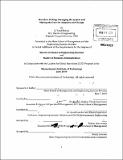Waveless picking : managing the system and making the case for adoption and change
Author(s)
Bishop, G. Todd (Gordon Todd)
DownloadFull printable version (10.91Mb)
Other Contributors
Leaders for Global Operations Program.
Advisor
Jérémie Gallien and David Simchi-Levi.
Terms of use
Metadata
Show full item recordAbstract
Wave-based picking systems have been used as the standard for warehouse order fulfillment for many years. Waveless picking has emerged in recent years as an alternative pick scheduling system, with proponents touting the productivity and throughput gains within such a system. This paper analyzes in more depth the differences between these two types of systems, and offers insight into the comparative advantages and disadvantages of each. While a select few pieces of literature perform some analyses of wave vs. waveless picking, this paper uses a case-study of a waveless picking system in an Amazon.com fulfillment center as a model for how to manage a waveless system once it has been adopted. Optimization methods for decreasing chute-dwell time and increasing throughput by utilizing tote prioritization are also performed using discrete-simulation modeling. The analysis concludes that managing waveless picking warehouse flow by controlling the allowable quantity of partially picked orders to match downstream chute capacity can lead to reduced control over cycle times and customer experience. Suggestions are also made on possible future research for how to optimally implement a cycle-time controlled system.
Description
Thesis (S.M.)--Massachusetts Institute of Technology, Engineering Systems Division; and, (M.B.A.)--Massachusetts Institute of Technology, Sloan School of Management; in conjunction with the Leaders for Global Operations Program at MIT, 2010. Cataloged from PDF version of thesis. Includes bibliographical references (p. 63-66).
Date issued
2010Department
Leaders for Global Operations Program at MIT; Massachusetts Institute of Technology. Engineering Systems Division; Sloan School of ManagementPublisher
Massachusetts Institute of Technology
Keywords
Engineering Systems Division., Sloan School of Management., Leaders for Global Operations Program.